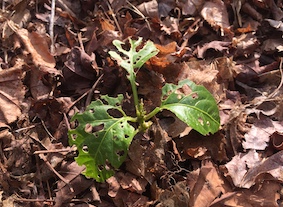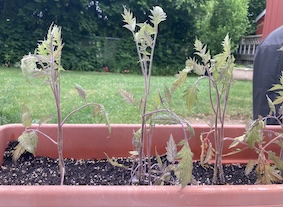Prevent Slug Damage
Views: 1399

The Slug Problem in Synopsis
In my last posting I described the signs of slug damage on my vegetable garden and also the environmental conditions that the holes were caused by these slimy creatures and not something else. In a nutshell, I was looking at small holes both within the whole leaf (like hole punches) and leaves that were chewed along the outer leaf margin (like a sandwich). Conditions had been moist/rainy/wet, the plants were low to the ground and within slug-chomping reach. My cover of leaf mulch on my new garden had provide the slugs with a cool, dark and moist home during the day, where they bided their time until darkness, when they’d come out and eat.
Slug Damage Solutions
What could I have done to prevent slug damage in the first place?
- Removing mulch. I could have pushed the leaf mulch away from around each of my vegetable plants. This would have made the plants a bit more out of reach for the slugs. I didn’t want to remove my entire covering of leaf mulch, so the slugs ended up still having a moist home for protection. This is the step I took to curb slug activity.
- The beer trick. Shallow containers (cat food or tuna fish cans) filled with beer attract slugs. Slugs are attracted to the beer, crawl into the container and drown. I’ve done this in the past with success. Keep in mind you end up with a dish full of gross, disintegrated slug goo that you will then have to dispose of somewhere (yuck).
- Make sliding hurt. Side dress your plants with a rough material which would make slug sliding difficult. For example, use coffee grounds, wood ashes, buckwheat hull mulch, pine needles or crushed eggs shells, all things that would tear into the slugs’ tender underbellies.
- Diatomaceous earth. This is another “rough material” technique, but I’ve heard mixed opinions about it. Such as, it loses some effectiveness when it gets wet, so you’d have to reapply after each irrigation or rain event; it not only harms slugs but also other beneficial insects such as bees; and it’s a health risk to humans if breathed in or makes contact with eyes.
- Natural slug baits. The newer slug baits are child- and pet-friendly methods that based on iron phosphate, which will kill slugs. Use as directed, because the baits are most effective when kept from rain and irrigation water. The container will have tips to prevent that.
- Copper sheets or wire. The wire is one of those “rough materials” to keep slugs away, but it turns out that I’ve read that copper gives slugs a bit of an electric shock, so a perimeter of copper wire or tape around your plants will give them a shock and turn them around.
- Encourage snakes, toads and frogs. These are just a few of the slugs’ natural predators.
- Trapping. Place a few boards or strips of cardboard in your garden. Slug will gather under these areas for protection after an evening of eating. In the morning, remove the boards/cardboard and gather up the slugs that have collected there and dispose of them in beer or by other methods.
One last way to prevent slug damage to your vegetable crops is to make your peace with them and offer them some flowers. That is, plant some other plants that slugs prefer over your vegetable crops, such as marigolds. They’ll lure the slugs away from your peppers and make your garden pretty at the same time.
Meet Ellen Wells
When you’re raised on a farm, you can’t help but know a thing or two about gardening. Ellen Wells is our expert on edible gardening.…
Ellen's Recent Posts

Container Tomatoes






